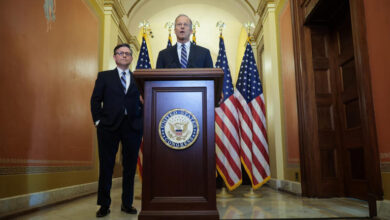Trump Leads in 5 Key States, as Young and Nonwhite Voters Express Discontent With Biden

The race was closer among likely voters. Mr. Trump led in five states as well, but Mr. Biden edged ahead in Michigan while trailing only narrowly in Wisconsin and Pennsylvania. While Mr. Biden won all six of those states in 2020, victories in Pennsylvania, Michigan and Wisconsin would be enough for him to win re-election, provided he won everywhere else he did four years ago.
The results were similar in a hypothetical matchup that included minor-party candidates and the independent candidate Robert F. Kennedy Jr., who won an average of 10 percent of the vote across the six states and drew roughly equally from the two major-party candidates.
The findings are mostly unchanged since the last series of Times/Siena polls in battleground states in November. Since then, the stock market has gained 25 percent, Mr. Trump’s criminal trial in Manhattan has started, and the Biden campaign has unleashed tens of millions of dollars in advertisements across the battleground states.
The polls offer little indication that any of these developments have helped Mr. Biden, hurt Mr. Trump or quelled the electorate’s discontent. Instead, the surveys show that the cost of living, immigration, the war in Gaza and a desire for change continue to be a drag on the president’s standing. While Mr. Biden benefited from a burst of momentum in the wake of his State of the Union address in March, he continues to trail in the average of national and battleground state polls.
The findings reveal widespread dissatisfaction with the state of the country and serious doubts about Mr. Biden’s ability to deliver major improvements to American life. A majority of voters still desire the return to normalcy promised by Mr. Biden in the last campaign, but voters in battleground states remain particularly anxious, unsettled and itching for change. Nearly 70 percent of voters say that the country’s political and economic systems need major changes — or even to be torn down entirely.
Only a sliver of Mr. Biden’s supporters — just 13 percent — believe that the president would bring major changes in his second term, while even many of those who dislike Mr. Trump grudgingly acknowledge that he would shake up an unsatisfying status quo.
The sense that Mr. Biden would do little to improve the nation’s fortunes has helped erode his standing among young, Black and Hispanic voters, who usually represent the foundation of any Democratic path to the presidency. The Times/Siena polls found that the three groups wanted fundamental changes to American society, not just a return to normalcy, and few believed that Mr. Biden would make even minor changes that would be good for the country.
Mr. Trump and Mr. Biden are essentially tied among 18-to-29-year-olds and Hispanic voters, even though each group gave Mr. Biden more than 60 percent of the vote in 2020. Mr. Trump also wins more than 20 percent of Black voters — a tally that would be the highest level of Black support for any Republican presidential candidate since the enactment of the Civil Rights Act of 1964.
The polls suggest that Mr. Trump’s strength among young and nonwhite voters has at least temporarily upended the electoral map, with Mr. Trump surging to a significant lead in the relatively diverse Sun Belt states, where Black and Hispanic voters propelled Mr. Biden to signature victories in the 2020 election.
Mr. Biden nonetheless remains within striking distance. He has maintained most of his support among older and white voters, who are much less likely to demand fundamental changes to the system and far likelier to say that democracy is the most important issue for their vote. As a result, Mr. Biden is more competitive in the three relatively white Northern swing states: Michigan, Pennsylvania and Wisconsin.
The economy and the cost of living, however, remain the most important issues for one-quarter of voters — and a significant drag on Mr. Biden’s prospects. More than half of voters still believe that the economy is “poor,” down merely a single percentage point since October despite cooling inflation, an end to rate hikes and significant stock market gains.
Nearly 40 percent of Mr. Trump’s supporters said that the economy or the cost of living was the most important issue in the election, among them Jennifer Wright, a registered nurse in Sterling Heights, Mich. She supported Mr. Trump in 2016 and 2020, and to her the election comes down to one question: “Who is the best candidate who is going to help me be in a financial situation to retire?”
“Even me, as a registered nurse, I’m buying Kroger brand or store brand. I’m not buying Jif. We’ve all had to cut back,” she said.
The Biden administration’s insistence that the economy is faring well has fallen flat for many voters, including Jacob Sprague, 32, who works as a systems engineer in Reno, Nev. He says that he voted for Mr. Biden in 2020 but will not be doing so this time.
“It is concerning to me when I keep seeing press come out of the White House where they keep saying the economy is good,” Mr. Sprague said. “That’s really weird because I’m paying more on taxes and more on groceries and more on housing and more on fuel. So that doesn’t feel good.”
With less than six months to go until the election, there is still time for an improving economy to lift Mr. Biden’s standing. Historically, polls at this early stage have not been necessarily indicative of the outcome, and Mr. Trump’s breakthrough among traditionally Democratic young, Black and Hispanic voters may not rest on a solid foundation. His strength is concentrated among irregular, disengaged voters who do not pay close attention to politics and may not yet be tuned into the race. They may be prone to shift their views as the race gets underway.
In a finding that will frustrate Democrats, even as it presents opportunity for Mr. Biden, nearly 20 percent of voters blame him more than they do Mr. Trump for the Supreme Court’s decision in 2022 to overturn Roe v. Wade. They may be the kind of voters that the Biden campaign hopes to persuade as the campaign heats up.
The polls showed that abortion loomed as one of Mr. Trump’s biggest vulnerabilities. On average, 64 percent of voters in battleground states said that abortion should be always or mostly legal, including 44 percent of Mr. Trump’s own supporters.
In recent weeks, the Biden campaign has sought to emphasize Mr. Trump’s support for the Supreme Court justices who overturned Roe v. Wade. For now, though, voters preferred Mr. Biden over Mr. Trump to handle the issue by 11 points, 49 to 38 percent.
A bigger challenge for Mr. Biden than disengaged voters may ultimately be the disaffected and the disillusioned — those who desire fundamental changes to American society, or who believe that the political and economic systems need to be torn down altogether. Not long ago, these anti-system voters might have been reliably Democratic, but Mr. Trump’s anti-establishment populist brand of conservatism has flipped the usual political dynamic.
Seventy percent of voters believe that Mr. Trump will either bring major changes to the political or economic system or tear down the systems altogether, compared with 24 percent who expect the same from Mr. Biden. And while many voters express deep reservations about Mr. Trump personally, 43 percent of voters believe that he will bring good changes to the country, compared with 35 percent who think the changes will be bad.
Mr. Trump fares especially well among those who believe that the political and economic systems ought to be torn down, a group that represents about 15 percent of registered voters. He leads among these anti-system voters by 32 points, and the tear-it-down voters are especially likely to have defected from the president. In contrast, Mr. Biden retains nearly all of his 2020 supporters who believe only minor changes are necessary.
These change voters are not necessarily demanding a more ideologically progressive agenda. In the last Times/Siena poll of the same states, 11 percent of registered voters thought that Mr. Biden was not progressive or liberal enough. And while many liberal or progressive voters want major changes, relatively few of those voters are defecting from Mr. Biden.
Instead, Mr. Biden’s losses are concentrated among moderate and conservative Democratic-leaning voters, who nonetheless think that the system needs major changes or to be torn down altogether. Mr. Trump wins just 2 percent of Mr. Biden’s “very liberal” 2020 voters who think the system at least needs major changes, compared with 16 percent of those who are moderate or conservative.
One exception is Israel’s war in Gaza, an issue on which most of Mr. Biden’s challenge appears to come from his left. Around 13 percent of the voters who say they voted for Mr. Biden last time, but do not plan to do so again, said that his foreign policy or the war in Gaza was the most important issue to their vote. Just 17 percent of those voters reported sympathizing with Israel over the Palestinians.
Gerard Willingham, 30, works as a web administrator and lives in Riverdale, Ga. He voted for Mr. Biden in 2020, but he plans to vote for a third-party candidate in November because of the president’s response to the conflict in Gaza, the issue about which he cares most right now.
“I think it’s made quite a bit of difference in that it made me more heavily than in the past push toward voting for a third party, even if I feel that the candidates almost 100 percent won’t win,” Mr. Willingham said. “It’s starting to reach into my moral conscience, I guess.”
Mr. Trump’s trial in Manhattan, on charges that he falsified business records related to a hush-money payment to cover up an affair with the adult film star Stormy Daniels, was already underway when the polls began in late April. However, the survey offered little indication that the trial had damaged the former president’s political fortunes, at least so far. Just 29 percent of voters in battleground states said that they were paying “a lot” of attention to Mr. Trump’s legal woes, and 35 percent thought that the trial was likely to end in a conviction.




